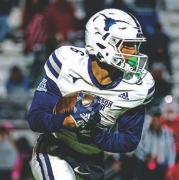2017 was a good year for horses
Clinton High FFA Endurance Team finishes successful year

Maggie Jeffers and her mount Bae when they placed first in the junior division.
FFA members Sammy Cooper, Michaela Stanton, Maggie Jeffers, and Micaiah Todd raced at Broxton Bridge in South Carolina, Leatherwood and Biltmore in North Carolina, Top of the Rock in Indiana, Skymont and Big South Fork.
Endurance rides range from 15 to 100 miles on horseback. Rides are set up in 10-15 mile segments with mandatory vet exams at the end of each segment.
The Clinton FFA team members and crew members Caleb Fox, Magen Farley, Amber Ray, Laura Goodrich, and Austin Ray volunteered throughout the year to assist teams of veterinarians who check the horse for heart rate, gait, digestive sounds, hydration and overall fitness.Preparation began here in Clinton as team members progressed through levels of horse and rider performance with strong coaching from FFA Advisors Morgan Watson, Erin Champion and Rodney Mann, that led to numerous achievements and awards throughout the year.
“I grew up on my family’s farm and always had horses, so horseback riding is just something that I have always done. What made me want to ride endurance though, is that I like to constantly grow as a rider and this was something new that I had not done before,” said Samantha Cooper.
The coaches say the endurance team offers the students many different opportunities. They learn to work as a team with not only each other but also with their horse. They learn to care for something whose success depends on their hard work and dedication. They are given the opportunity to job shadow veterinarians and event managers.
They are taught the value of hard work and they are given the opportunity to travel and experience areas in the southeastern United States in a way that many people of this world will never experience. Additionally, students get to experience the highs and lows of sport which we consider to be “character building” experiences.
Michaela Stanton knows what that means: “This team has brought so many learning experiences. Especially when it comes to how the horse’s body works and what they need to be healthy athletes.There are so many things that I’ve learned these past two years its amazing how much work you put into this sport.
Added Cooper, “This is different from other horseback riding sports that I have done. It is quite the opposite of barrel racing. In barrels you ride for just a few fast seconds. In endurace, you ride many miles for many hours. Also, the endurance atmosphere is very different from showing racking horses and ranch horses.”
Have you ever seen the movie Hidalgo?
Well if you have, that is exactly what the team does.
An edurance race is organized in “loops” of trail that vary in mileage from 10-15 miles. After each loop, the students and their horses will arrive back at the base camp where they will cool down their horses until the horse has reached a heartrate of 64 beats per minute.
The riders will then take the horse to the vet check where the horse will receive a full veterinary inspection to ensure that the horse is “fit to continue.”
This inspection evaluates everything from hydration to gut sounds and movement, respiration rate, muscle tone, body conditioning scores and soundness which checks to make sure that the horse is not limping or experiencing any pain while moving.
If the horse fails any of these aspects of the check, they are eliminated and asked to see an additional veterinarian who ensures that the horse is in good health and does not need serious treatments.
Once the horse and rider team pass their vet exam, they are required to rest their horses for roughly 40 minutes allowing the pair to both eat, drink and relax to fuel themselves for the next loop of trail where they will go through this entire process again. Think of them as marathon runners.
“Endurance racing is just like any other sport you have to train as athletes, and prepare for your race. I think its harder than any sport I’ve ever played because it takes so much prep time to get ready,” Stanton said.
Competitions begin early in the morning around 6 or 7 a.m. In the 25 mile ride, they are allowed six hours to complete the course. In the 50 mile division, they are allowed 12 hours to complete. However, it typically takes them about 7-8 hours to finish a 50 and roughly four hours to finish a 25.
Maggie Jeffers said, “It’s very hands on, and its more than just me and my skills its the cooperation between you and your horse.”
Travel to events is paid for by the coaches. Fuel usually costs roughly $150-$200 per rig and we travel three truck and trailer rigs loaded down with horses. Hay and grain usually costs around $20 per horse per weekend trip (ninehorses typically travel).
Aisin Automotive has sponsored the team and an individual from the endurance community has contributed a small donation as well. All other costs including veterinary care, and people and horse food for the weekend trips have been absorbed by the coaches.
The team was formed in August of 2016 and has been growing ever since.

